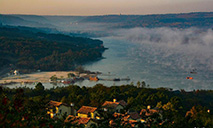Interview: Tonga volcanic eruption not likely to cause global climate change, says New Zealand volcanologist
AUCKLAND, New Zealand, Jan. 18 (Xinhua) -- The Tonga volcanic eruption is not likely to cause global climate change, while the volcanic ash and acid rain may damage crops and water supply, a leading New Zealand volcanologist said Monday.
Professor Shane Cronin of the University of Auckland, who visited the Hunga-Tonga Hunga-Ha'apai volcano in November 2015, has explained the uniqueness of the volcanic event and its impacts.
According to the professor, the most significant impact so far has been the tsunami generated at the beginning of the eruption.
"Thankfully, the tsunami in Tonga was not so big," said the professor.
All the homes on one of Tonga's small outer islands were destroyed in the massive volcanic eruption and tsunami, with three people confirmed dead so far, the government said on Tuesday in its first update since the disaster hit.
"But mostly the damage is not so far from the coast and especially confined to a few very low-lying areas. Thankfully, most people were able to get away from those waves," he said.
The other impacts locally in Tonga are from the ashfall. "Thankfully again, the ashes mostly fell into the ocean. On the Tongatapu island, there were reports of two centimeters of ash. This ash will impact water supply and some broad-leaf crops like corn, banana and squash, but unless there are more eruptions, this effect should allow a quick plant recovery."
Professor Cronin noted that most of the volcanic plumes from Saturday's eruption were in the troposphere or lower part of the atmosphere, below 25 km. Along with this short eruption means that there is not much aerosol to reflect sunlight and cause global cooling.
"Most of the ash plume and gas plume that went into the air contains gases like sulpha dioxide. The rain will wash them down. There was not too large a volume of particles and aerosols high enough in the atmosphere to cause global cooling," he said.
But the impact from acid rains for the affected areas such as Tonga and parts of eastern Fiji could be real. Should there be many more eruptions to come, and the acid rain continues, it could be more damaging for crops and water supply.
The longer-term effects of the volcanic eruption on marine life could be significant, he said.
On the downside, the local fishing and marine life will experience many changes as part of the volcano is destroyed. But there is some bright side along with the volcanic ashes in the longer term.
"Because when ash falls into the ocean, it brings with it nutrients. For example, It can bring iron, which is usually quite low in the ocean. It can suddenly create a bloom of plankton, which then go through the food chain, creating a population boom later on the fish and other lives too," said Professor Cronin.
According to the professor, a series of more minor eruptions happened in the submarine volcano in 1998, 2009, 2014, 2015 and perhaps even earlier than that. Saturday's eruption was so severe because a lot of the magma in the volcano had been building up for at least 10 years, or maybe longer.
"The magma accumulates to a large size inside the volcano. The pressure of the magma, built up to a point that the top of the volcano can no longer hold it. At this point cracks start to happen, until suddenly the magma is released. The magma is full of gas and it expands extremely rapidly," said Professor Cronin.
The central part of the Hunga volcano is about 150 meters to 300 meters below sea level. The amount of water that went into the crater was just big enough to fuel the big explosion that has sent waves of air pressure traveling around the world.
"Also, tsunami waves were generated by the initial expansion as well as by changes in the surface on the top of the volcano," Professor Cronin said.
"The maximum power of this eruption was very strong, equivalent to the Mount Pinatubo eruption in 1991 in the Philippines. However, the Saturday eruption was a very short one. It lasted less than 10 minutes for its main active phase. In contrast, the Pinatubo lasted for many hours," he said.
The short period means that the overall amount of materials released from this eruption was relatively small. "We think around 0.5 cubic kilometers of materials was ejected into the air," Cronin said.
The professor's best guess is the lower level of the VEI 5 range. "Which is roughly one per 10 years around the world for such a size," he said. "It may be more sort of normal mid-scale large eruption volume."
However, it is very difficult to predict what might happen next.
"I would suggest that the eruption may be less violent from now on because the beginning of this eruption was all these pent-up magmas with a lot of trapped gas in it," Professor Cronin said.
Photos
Related Stories
- In pics: Before and after satellite images of volcanic eruption in Tonga's Hunga Ha'apai island
- UN, agencies prepare relief efforts following Tonga volcano eruption
- Concerns mounting over tsunami-hit Tonga as countries pledge aid
- China ready to provide support, assistance at Tonga's request: spokesperson
- Japan's weather agency warns of tsunami following volcanic eruption in Tonga
Copyright © 2022 People's Daily Online. All Rights Reserved.










